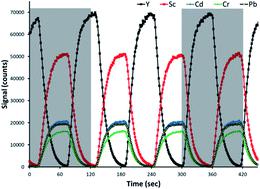当前位置:
X-MOL 学术
›
J. Anal. At. Spectrom.
›
论文详情
Our official English website, www.x-mol.net, welcomes your feedback! (Note: you will need to create a separate account there.)
Automated standard dilution analysis
Journal of Analytical Atomic Spectrometry ( IF 3.4 ) Pub Date : 2019-11-25 , DOI: 10.1039/c9ja00339h Willis B. Jones 1, 2, 3, 4 , George L. Donati 1, 2, 3, 4 , Clifton P. Calloway 4, 5, 6, 7 , Bradley T. Jones 1, 2, 3, 4
Journal of Analytical Atomic Spectrometry ( IF 3.4 ) Pub Date : 2019-11-25 , DOI: 10.1039/c9ja00339h Willis B. Jones 1, 2, 3, 4 , George L. Donati 1, 2, 3, 4 , Clifton P. Calloway 4, 5, 6, 7 , Bradley T. Jones 1, 2, 3, 4
Affiliation

|
Standard dilution analysis (SDA) is a recently described calibration method that combines internal standardization and standard additions to improve accuracy and precision. By combining these two traditional methods, SDA offers corrections for sample matrix effects while also minimizing signal fluctuations due to changes in the excitation source and the sampling process. In its most basic form, SDA is performed by introducing a constant amount of sample into an instrument while varying the amount of standard solution added to the sample. The procedure is simple to perform by hand, but automation of the process is challenging because the dilution of the standard solution by a blank occurs on-line while the measurement is taking place. The experiments presented here are aimed at improving the automation of the SDA process. Inductively coupled plasma optical emission spectrometry (ICP OES) is used as a model for SDA applications, although the calibration method is applicable to any technique that accepts samples as a liquid flow. The end goal of automation is for successive samples to be analyzed quickly by using an automatic sampler to switch from sample to sample, as it is the case in routine analytical methods. The required dilution of the standard by a blank mixture is achieved through the use of a two-channel pinch valve, with dilution occurring by diffusion as the solution is pulled from the valve toward the plasma by a second channel in the instrument's peristaltic pump. The proposed automated SDA method is effective, with analyte recoveries within a few percent of 100 for the elements evaluated (i.e. Al, Cd, Co, Cr, Cu, Fe, Ni and Pb) and nine different sample matrices. The method also provides promising results when analyzing real-world samples. The limits of detection obtained with the automated SDA method are similar to those typically found for external standard calibration and ICP OES, falling within the single-digit μg L−1 range.
中文翻译:

自动化标准品稀释分析
标准稀释分析(SDA)是最近描述的一种校准方法,该方法将内部标准化和标准添加相结合,以提高准确性和精密度。通过将这两种传统方法结合在一起,SDA可以校正样本矩阵的影响,同时还可以最大程度地减少由于激发源和采样过程的变化而引起的信号波动。在其最基本的形式中,通过将恒定量的样品引入仪器中,同时改变添加到样品中的标准溶液的量来执行SDA。手工操作过程很简单,但过程的自动化却颇具挑战性,因为在进行测量时,空白溶液会在线稀释标准溶液。这里介绍的实验旨在改善SDA过程的自动化。电感耦合等离子体发射光谱(ICP OES)用作SDA应用的模型,尽管校准方法适用于任何将样品作为液体流动的技术。自动化的最终目标是通过使用自动进样器在样品之间进行切换来快速分析连续的样品,这在常规分析方法中就是这种情况。使用空白通道的夹管阀可实现标准品的空白混合物稀释,当溶液被仪器的蠕动泵中的第二个通道从阀向血浆拉出时,扩散通过扩散进行稀释。拟议的自动SDA方法是有效的,对于所评估的元素,分析物的回收率在100%的百分之几内 尽管校准方法适用于将样品作为液体流接受的任何技术。自动化的最终目标是通过使用自动进样器在样品之间进行切换来快速分析连续的样品,这在常规分析方法中就是这种情况。使用空白通道的夹管阀可实现标准品的空白混合物稀释,当溶液被仪器的蠕动泵中的第二个通道从阀向血浆拉出时,扩散通过扩散进行稀释。拟议的自动SDA方法是有效的,对于所评估的元素,分析物的回收率在100%的百分之几内(尽管校准方法适用于将样品作为液体流接受的任何技术。自动化的最终目标是通过使用自动进样器在样品之间进行切换来快速分析连续的样品,这在常规分析方法中就是这种情况。使用空白通道的夹管阀可实现标准品的空白混合物稀释,当溶液被仪器的蠕动泵中的第二个通道从阀向血浆拉出时,扩散通过扩散进行稀释。拟议的自动SDA方法是有效的,对于所评估的元素,分析物的回收率在100%的百分之几内(自动化的最终目标是通过使用自动进样器在样品之间进行切换来快速分析连续的样品,这在常规分析方法中就是这种情况。使用空白通道的夹管阀可实现标准品的空白混合物稀释,当溶液被仪器的蠕动泵中的第二个通道从阀向血浆拉出时,扩散通过扩散进行稀释。拟议的自动SDA方法是有效的,对于所评估的元素,分析物的回收率在100%的百分之几内(自动化的最终目标是通过使用自动进样器在样品之间进行切换来快速分析连续的样品,这在常规分析方法中就是这种情况。使用空白通道的夹管阀可实现标准品的空白混合物稀释,当溶液被仪器的蠕动泵中的第二个通道从阀向血浆拉出时,扩散通过扩散进行稀释。拟议的自动SDA方法是有效的,对于所评估的元素,分析物的回收率在100%的百分之几内(当溶液通过仪器蠕动泵中的第二个通道从阀向血浆中拉出时,由于扩散而发生稀释。拟议的自动SDA方法是有效的,对于所评估的元素,分析物的回收率在100%的百分之几内(当溶液通过仪器蠕动泵中的第二个通道从阀向血浆中拉出时,由于扩散而发生稀释。拟议的自动SDA方法是有效的,对于所评估的元素,分析物的回收率在100%的百分之几内(例如Al,Cd,Co,Cr,Cu,Fe,Ni和Pb)和九种不同的样品基质。当分析现实世界的样本时,该方法还提供了令人鼓舞的结果。用自动SDA方法获得的检测限与外标校准和ICP OES的典型检测限相似,均在单位μgL -1范围内。
更新日期:2019-11-25
中文翻译:

自动化标准品稀释分析
标准稀释分析(SDA)是最近描述的一种校准方法,该方法将内部标准化和标准添加相结合,以提高准确性和精密度。通过将这两种传统方法结合在一起,SDA可以校正样本矩阵的影响,同时还可以最大程度地减少由于激发源和采样过程的变化而引起的信号波动。在其最基本的形式中,通过将恒定量的样品引入仪器中,同时改变添加到样品中的标准溶液的量来执行SDA。手工操作过程很简单,但过程的自动化却颇具挑战性,因为在进行测量时,空白溶液会在线稀释标准溶液。这里介绍的实验旨在改善SDA过程的自动化。电感耦合等离子体发射光谱(ICP OES)用作SDA应用的模型,尽管校准方法适用于任何将样品作为液体流动的技术。自动化的最终目标是通过使用自动进样器在样品之间进行切换来快速分析连续的样品,这在常规分析方法中就是这种情况。使用空白通道的夹管阀可实现标准品的空白混合物稀释,当溶液被仪器的蠕动泵中的第二个通道从阀向血浆拉出时,扩散通过扩散进行稀释。拟议的自动SDA方法是有效的,对于所评估的元素,分析物的回收率在100%的百分之几内 尽管校准方法适用于将样品作为液体流接受的任何技术。自动化的最终目标是通过使用自动进样器在样品之间进行切换来快速分析连续的样品,这在常规分析方法中就是这种情况。使用空白通道的夹管阀可实现标准品的空白混合物稀释,当溶液被仪器的蠕动泵中的第二个通道从阀向血浆拉出时,扩散通过扩散进行稀释。拟议的自动SDA方法是有效的,对于所评估的元素,分析物的回收率在100%的百分之几内(尽管校准方法适用于将样品作为液体流接受的任何技术。自动化的最终目标是通过使用自动进样器在样品之间进行切换来快速分析连续的样品,这在常规分析方法中就是这种情况。使用空白通道的夹管阀可实现标准品的空白混合物稀释,当溶液被仪器的蠕动泵中的第二个通道从阀向血浆拉出时,扩散通过扩散进行稀释。拟议的自动SDA方法是有效的,对于所评估的元素,分析物的回收率在100%的百分之几内(自动化的最终目标是通过使用自动进样器在样品之间进行切换来快速分析连续的样品,这在常规分析方法中就是这种情况。使用空白通道的夹管阀可实现标准品的空白混合物稀释,当溶液被仪器的蠕动泵中的第二个通道从阀向血浆拉出时,扩散通过扩散进行稀释。拟议的自动SDA方法是有效的,对于所评估的元素,分析物的回收率在100%的百分之几内(自动化的最终目标是通过使用自动进样器在样品之间进行切换来快速分析连续的样品,这在常规分析方法中就是这种情况。使用空白通道的夹管阀可实现标准品的空白混合物稀释,当溶液被仪器的蠕动泵中的第二个通道从阀向血浆拉出时,扩散通过扩散进行稀释。拟议的自动SDA方法是有效的,对于所评估的元素,分析物的回收率在100%的百分之几内(当溶液通过仪器蠕动泵中的第二个通道从阀向血浆中拉出时,由于扩散而发生稀释。拟议的自动SDA方法是有效的,对于所评估的元素,分析物的回收率在100%的百分之几内(当溶液通过仪器蠕动泵中的第二个通道从阀向血浆中拉出时,由于扩散而发生稀释。拟议的自动SDA方法是有效的,对于所评估的元素,分析物的回收率在100%的百分之几内(例如Al,Cd,Co,Cr,Cu,Fe,Ni和Pb)和九种不同的样品基质。当分析现实世界的样本时,该方法还提供了令人鼓舞的结果。用自动SDA方法获得的检测限与外标校准和ICP OES的典型检测限相似,均在单位μgL -1范围内。


























 京公网安备 11010802027423号
京公网安备 11010802027423号